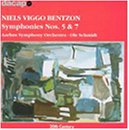| All Artists: Bentzon, Aarhus Sym Orch, Schmidt Title: Symphonies 5 & 7 Members Wishing: 0 Total Copies: 0 Label: Da Capo [Naxos] Release Date: 11/30/1999 Genre: Classical Style: Symphonies Number of Discs: 1 SwapaCD Credits: 1 UPC: 730099981125 |
Search - Bentzon, Aarhus Sym Orch, Schmidt :: Symphonies 5 & 7
 | Bentzon, Aarhus Sym Orch, Schmidt Symphonies 5 & 7 Genre: Classical
|
Larger Image |
CD Details |
CD ReviewsBentzon's Accessible Modernism Thomas F. Bertonneau | Oswego, NY United States | 01/27/2001 (4 out of 5 stars) "Niels Viggo Bentzon (born 1919) composes copiously and has done so for more than six decades: The sum and total of his music constitutes an incalculable mass from which, now and then, some hint of the remainder emerges to signify this quirky and fecund talent. The Da Capo release of two of Bentzon's symphonies, the Fifth (1950) and Seventh (1953), shows a host of influences (Hindemith, Shostakovich, Prokofiev, and Nielsen) refracted through an individual creativity that adds its own qualities to the inevitable reactions and imitations. Bentzon belongs to a group of Nordic composers who embraced what Bentzon himself, following his teacher Vagn Holmboe, referred to as the "metamorphosis principle." Less rigorous than Schoenberg's dodecaphonic method, the "metamorphosis principle" nevertheless seeks to derive all the material of a given work from a few pregnant cells heard usually at the beginning. You might call it "tonal serialism." One of Bentzon's symphonies, the Fourth (1948), actually bears the subtitle "Symfoniske Metamorfoser." So might the Fifth (subtitled "Ellipser"), because all its variety of moods and means, apportioned among five considerable movements, stems from a few motifs and gestures deployed at the outset. The elemental rhythm consists of a quarter-note in moderate tempo followed by two eighth-notes, with this pattern repated twice-in-a-bar. In the First Movement (Moderato), brassy march-episodes and harmonically ambiguous passages for strings and celesta build themselves up over this basic rhythmic pulse. The Allegro that follows has the sharp outlines of a Shostakovich scherzo. In the Adagio, the Symphony's centerpiece, Bentzon comes close to his mentor, Holmboe: The dense string-polyphony suggests subterranean processes; the persistent snare-drum tattoo reminds us of the nearness (less than five years) of the war and the German occupation. Another scherzo follows. The Finale is marked "Sostenuto." The Seventh Symphony requires thirty minutes to the Fifth's nearly forty; subtitled "De Tre Versioner" ("The Three Versions"), it too is an essay in metamorphotic procedures. The material is less variegated, more austere. But there is never any doubt that one stands in the presence of a true master. Ole Schmidt leads the redoubtable Aarhus Symphony Orchestra in recordings from twenty years ago. Slightly bass-heavy. But compelling."
|

 Track Listings (6) - Disc #1
Track Listings (6) - Disc #1